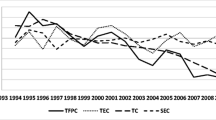Abstract
Using a unique survey database of more than 55,000 firms in more than 100 countries, we explore the impact of water and its scarcity on firms. Even though, about 1 in 3 firms require water and 1 in 4 of those firms experience insufficient water supply, productivity of firms using water is higher than productivity of firms not requiring water. Even with or without water shortage problems, productivity of large firms using water is higher than productivity of all other firms. Productivity of manufacturing firms requiring no water is lower than productivity of all other firms. A firm’s perception about corruption does not have any influence on its productivity irrespective of whether it uses water or it experiences water scarcity.
Similar content being viewed by others
References
2030 Water Resources Group (2008) Charting our water future, Economic frameworks for inform decision making, http://www.mckinsey.com/App_Media/Reports/Water/Charting_Our_Water_Future_Exec%20Summary_001.pdf
Alvarez R and López R A (2006) Entry and Exit in International Markets: Evidence from Chilean Data. CAEPR Working Paper No. 2006–014. Available at SSRN: 10.2139/ssrn.650922
Buytaert W, De Bièvre B (2012) Water for cities: the impact of climate change and demographic growth in the tropical Andes. Water Resour Res. doi:10.1029/2011WR011755
Carbon Disclosure Project (2012) Global Water Report 2012, Collecting responses to rising water challenges, https://www.cdproject.net/CDPResults/CDP-Water- Disclosure-Global-Report-2012.pdf
Crawford M, Seidel S (2013) Weathering the storm: Building business resilience to climate change, Center for Climate and Energy Solutions, http://www.c2es.org/publications/weathering-storm-building-business-resilience-climate-change
Ercin AE, Aldaya MM, Hoekstra AY (2011) Corporate water footprint accounting and impact assessment: the case of the water rootprint of a sugar-containing carbonated beverage. Water Resour Manag 25:721–741. doi:10.1007/s11269-010-9723-8
Ernst and Young (2012) Water resources at the corporate level: Moving from a risk based approach to active management, New York: Ernst and Young
Food and Agriculture Organisation (2011) State of the World’s Land and Water Resources for Food and Agriculture, http://www.fao.org/nr/solaw/solaw-home/en/
Freire-González J (2011) Assessing the macroeconomic impact of water supply restrictions through an input–output analysis. Water Resour Manag 25:2335–2347
Gatti R and Love I (2008) Does access to credit improve productivity? Evidence from Bulgaria. Econ Transit 16: 445–465. doi:10.1111/j.1468-0351.2008.00328.x
Hoekstra AY, Chapagain AK (2007) Water footprints of nations: water use by people as a function of their consumption pattern. Water Resour Manag 21(1):35–48
Javorcik BS (2004) Does foreign direct investment increase the productivity of domestic firms? in search of spillovers through backward linkages. Am Econ Rev 94(3):605–627
Kattenberg A, Giorgi F, Grassl H, Meehl GA, Mitchell JFB, Stouffer RJ, Tokioka T, Weaver AJ, Wigley TML (1996) Climate models - projections of future climate. In: Houghton JT, Filho LGM, Callander BA, Harris N, Kattenberg A, Maskell K (eds) Climate change 1995: the science of climate change, 285–357. Cambridge University Press, Cambridge
Ku S, Yoo S (2012) Economic value of water in the Korean manufacturing industry. Water Resour Manag 26:81–88
Maxwell, S (Ed.,) (2011) The business of water: A concise overview of challenges and opportunities in the water market, ISBN 978-1-58321-556-2
National Academy of Sciences (2012a) Perception of Climate Change.
National Oceanic and Atmospheric Administration (2013) http://oceanservice.noaa.gov/facts/wherewater.html Jan 11, 2013
SAS Institute Inc (2009) SAS/STAT User’s Guide, Chapter 48 The Orthoreg Procedure, Version 8 SAS Institute Inc., Cary, NC, USA
The National Academy of Sciences (2012) The Water Footprint of Humanity http://www.pnas.org/content/109/9/3232.full.pdf+html
The World Bank (2013) The Enterprise Surveys (http://www.enterprisesurveys.org)
UN News Center (2010) http://www.un.org/apps/news/story.asp?NewsID =35456&Cr = SANITATION
Van Oel PR, Hoekstra AY (2012) Towards quantification of the water footprint of paper: a first estimate of its consumptive component. Water Resour Manag 26:733–749. doi:10.1007/s11269-011-9942-7
Acknowledgments
The author thanks Dean Neil S. Braun of Lubin School of Business, Pace University for financially supporting this research through the Summer Research Grant.
Author information
Authors and Affiliations
Corresponding author
Rights and permissions
About this article
Cite this article
Bhat, V.N. Water and Its Effect on Business Productivity: A Cross-Country Analysis. Water Resour Manage 29, 4007–4020 (2015). https://doi.org/10.1007/s11269-015-1042-7
Received:
Accepted:
Published:
Issue Date:
DOI: https://doi.org/10.1007/s11269-015-1042-7




